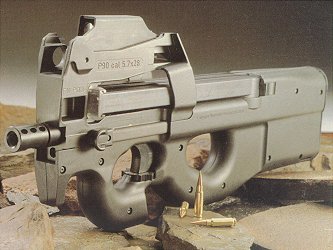Definitions
Previous Section:
 General
General
Gun Types
Guns can be divided into those that are fired hand-held
and those that are braced against the shoulder for firing.
The former are called pistols, while the latter
are referred to generically as long guns.
Generally soldiers are issued shoulder-fired rifles.
Military officers may carry pistols as backup defensive arms.
Pistol
Pistol can refer to the general class of hand-fired guns.
A more specific use of the term "pistol"
is for self-loading (semiautomatic), magazine-fed hand guns.
Another type of pistol is the revolver. Revolvers have
a single barrel but use a rotating cylinder with multiple
chambers to provide a repeating action. Because this
operating method is fundamentally different from self-loading
arms, operation of revolvers is not described further.
Pistol rounds are usually used at distances of less than 50 meters.
Rifle
A rifle is a shoulder-fired arm utilizing a relatively
high-velocity round. They are capable of accurate fire
out to a few hundred meters.
The term rifle derives from the rifling of the barrel.
Rifling is typically helical ridges formed on the inside
of the barrel through hammering or drawing.
As the projectile engages the rifling it
imparts spin. The spin gyroscopically stabilizes the
flight of the projectile once it has left the barrel,
giving it greater precision over longer distances.
Rifled barrels were a major military advance
starting before 1800.
Pistol barrels are usually rifled.
Carbine
A carbine is usually a shorter, lighter rifle. It can also
refer to pistol-caliber, shoulder-fired light arms.
Carbines were originally developed to improve the mobility of
horse-riding cavalry soldiers.
Machine Gun
A machine gun is usually a rifle-caliber or larger, crew-served,
belt-fed automatic firearm.
Traditionally one rifle-caliber machine gun is deployed per
platoon-sized (8 person) unit.
Larger machine guns, such as the .50 caliber Browning M2
are used in vehicle- or tripod-mounted applications.
Submachine Gun
A submachine gun is a pistol-caliber, magazine-fed, individual
automatic firearm. In military environments
they are traditionally deployed in special operations
commando units where mobility is key,
or tank crews where space inside the vehicle is tight.
In police environments they are deployed in counter-terrorist
or special weapons units.
Since they usually have longer barrels than pistols submachine
guns make more efficient use of pistol ammunition and are effective
out to about 100 meters, though traditionally they are
deployed at shorter distances.
They are usually shoulder-fired for better accuracy.
Assault Rifle
A true assault rifle is a small, rifle-sized, fully-automatic
arm chambered for an intermediate-power rifle round such
as 7.62 x 39mm (Soviet) or 5.56 x 45mm (NATO).
Current examples include the AK-47, AK-74, M16, and Steyr AUG.
Note that true assault rifles are the fully automatic military versions,
not the semi-automatic versions commercially available in the U.S.

The recently designed FN P90 Personal Defense Weapon falls
somewhere between the submachine gun and assault rifle categories.
It fires a small, light, 5.7 x 28mm rifle-caliber round
but is about the size of a submachine gun.
The P90 was designed for support troops other than
assault infantry, who need full-sized assault rifles.
The effectiveness of this new round in combat has not been fully determined.
Shotgun
A shotgun is a shoulder-fired arm. Most have barrels
with smooth bores and fire loads of multiple lead or steel shot
(balls individually or collectively called shot).
Shotguns are found in hunting, target shooting, military,
police, and self-defense applications. Shotguns can
also fire slugs (a single large projectile) from smooth or
rifled barrels. Shot is effective to about 40
meters or less. Slugs are effective out to about 100 meters or less.
Shotguns are usually used at the shorter end of these ranges.
Cannon
Cannon are automatic guns of calibers 20mm to about 40mm,
mounted on vehicles such as aircraft and armored vehicles.
Next Section:
Ammunition Components

 Back to Definitions Index
Back to Definitions Index
 Back to Main Index
Back to Main Index

 General
General
